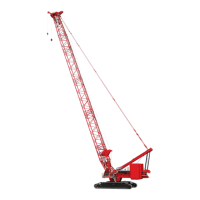Manitowoc Published 05-26-17, Control # 238-02 8-7
MLC165-1 SERVICE/MAINTENANCE MANUAL UNDER CARRIAGE
CRAWLER PREVENTATIVE MAINTENANCE
Crawler wear cannot be eliminated, but the rate of wear can
be reduced through regular preventive maintenance. Repair
or replace damaged parts immediately to prevent further
damage.
• Lubricate the crawlers as instructed in Lubrication Guide
supplied with the crane.
• Keep the crawlers clean and avoid dirt build-up when
cutting.
• Keep all mounting bolts tight (see Parts Manual for
applicable torque values).
• Keep the treads properly adjusted.
• Inspect the crawler frames, rollers, and treads on a
regular basis.
• Check for oil leaks, excessive wear, cracks, and other
damage. Broken or cracked parts can indicate that the
treads are adjusted too tightly.
CRAWLER TREAD SLACK MEASUREMENT
See Figure 8-4 for the following procedure.
Check the tread slack at roller end of each crawler. Maintain
equal tread slack at both crawlers.
1. Position the crane to travel with tumblers leading in
direction of travel. Do not travel with front rollers leading.
2. Travel on a firm level surface until maximum amount of
slack can be seen (about half of one crawler length).
3. Place a straight edge (13) on top of the tread. Measure
the gap (14) between the straight edge and the head of
the pin keeper bolt.
4. If the gap exceeds the limits listed below, adjust the
crawler tread slack as described in the following
procedure.
• 1.0 in (25 mm) Tight Limit
• 2.2 in (55 mm) Loose Limit
NOTE In order to obtain the most accurate measurement
possible, stop the tracks at different locations to
check multiple positions of the pads relative to the
frame.
CRAWLER TREAD SLACK ADJUSTMENT
See Figure 8-4 for the following procedure.
Adjust the treads tighter when operating on firm ground and
looser when operating on soft ground (mud or sand).
Adjust tread slack at the roller end of each crawler.
1. Thoroughly clean the crawler to be adjusted.
2. Remove the covers (2) from both sides of crawler frame.
3. Loosen the nut (1) on each side of the crawler roller (8).
4. Place the jacking cylinder (3) on the support (4).
5. Using the hand pump, extend the jacking cylinder (see
Operation on page 8-9
) against the rod (5) equal
distances at both sides of the crawler frame.
6. Add or remove an equal thickness of shims (6a & 6b) on
both sides of crawler frame.
7. Relieve the pressure in the jacking cylinder and remove
it.
8. Travel the crane forward or reverse to tighten the shims.
9. Verify that the left and right crawler dimensions,
measured from the center punch in the shaft (10) to the
center punch line in the crawler frame (11), are within 1/
8 in (3 mm) of each other.
10. Check for proper crawler slack adjustment and readjust
as required (step 4
through step 9).
11. Lubricate the nuts and bolts at the crawler rollers with
Never-Seez or an equivalent anti-seizing lubricant.
12. Tighten the nut on the bolt to 1,000 ft-lb (1,356 Nm).
13. Install the cover (2) on both sides of crawler frame.
NOTE The extreme limit of tread adjustment occurs when
the bolts are tight against front end of the slots in
crawler frame. One crawler tread can be removed
when this limit is reached.
CAUTION
Tread Pin Damage
Do not adjust the treads too tight or the tread pins will
wear rapidly and may break. Dirt build-up will tighten the
treads further, increasing the possibility of damage.
Tight treads require more drive torque, resulting in faster
wear and increased fuel consumption.
CAUTION
Parts Wear
The crawler roller and tumbler must be square with the
crawler frame to within 1/8 in (3 mm), or parts will wear
rapidly.
